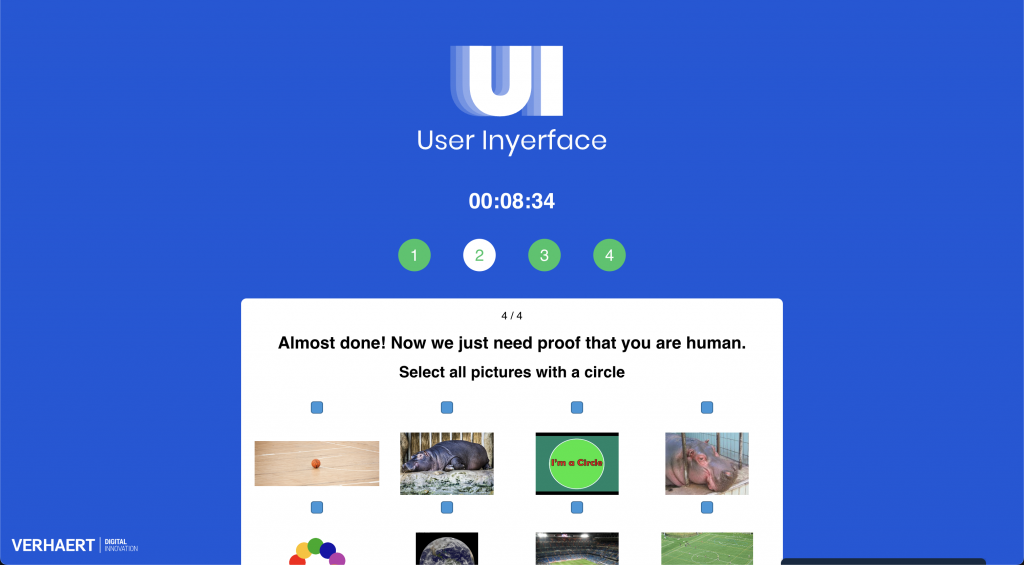This week’s task involved playing the online game User Inyerface (Bagaar, 2019) and reporting back on our experience.

I found this task to be both fun and frustrating, and in many ways, reminded me of an escape room challenge in the form of web page. The game managed to subvert my expectations a number of times, and in the end I only got as far as part 4, despite following all of the instructions. After about 5 minutes of trying to get through part 4, I decided to call it quits. I then watched a speed run of the game by Kittrz (2019) to understand what went wrong, only to discover that the successful course of action (checking all boxes on the page) contradicts the game instructions.
Contradictory instructions is just one example of how User Inyerface makes use of deceptive and/or inaccessible web UI to prevent users from achieving their goals and purposes. This is also achieved through the game’s use of broken and/or mislabeled UI elements, such as the green, circular ‘no’ button on the main screen, or alerts like the cookies notification and timer warnings. Other UI elements were simply unintuitive (e.g., checkboxes and text entry fields that wouldn’t clear by default) or inaccessible (e.g., no tab key functionality to navigate between elements).
User Inyerface (Bagaar, 2019) effectively demonstrates the capacity for web-based artifacts to employ deceptive, inaccessible and simply counterintuitive designs. Some of these designs reflected what Brignull (2011) describes as dark patterns, which are user interfaces intentionally designed to deceive users and to serve commercial interests. For example, the confluence of deceptive and prohibitive UI in User Inyerface (e.g., confusing instructions, disabled buttons/links, checkboxes that contradict the labels, etc.) resembles a pattern that Brignull (n.d.) refers to as the “roach motel”, which is designed to lures users in and make it difficult to escape. Similar to how Amazon uses this pattern to make it difficult for users to cancel their membership (Nerdwriter1, 2018, 00:19), User Inyerface does so to prevent users from completing the game. In addition to the use of dark patterns, the inaccessible interface elements in the game (e.g., inability to tab navigate between elements) reflects the inequitable conditions that users with disabilities may encounter on the web.
Overall, this was an interesting exercise and made salient the need for more transparent, accessible, and user-centered interfaces (Brignull, 2011). In particular, it raises a number of considerations for my own work in the domain of post-secondary education:
- The vetting of any commercial/proprietary technologies used in the learning environment (software/tools/subscriptions), so that learners are safeguarded by dark patterns (or at minimum, afforded transparency and alternatives).
- Designing instruction with usability principles in mind, so that learners are able to successfully achieve their purposes (e.g., online modules, activities, resources, the LMS).
- Adhering to (and advocating for) web accessibility standards when designing web-based learning environments.
- Ensuring that critical thinking and awareness of dark patterns is reflected in digital literacy instruction.
References
Brignull, H. (2011). Dark patterns: Deception vs. honesty in UI design. A List Apart, 338. https://alistapart.com/article/dark-patterns-deception-vs-honesty-in-ui-design/
Brignull, H. (n.d.). Roach motel. Deceptive Designs. https://www.deceptive.design/types/roach-motel
Bagaar. (2019). User Inyerface [web game]. https://userinyerface.com/
Kittrz. (2019, July 4). User Inyerface speedrun [Video]. YouTube. https://youtu.be/SH84z78F9gY
Nerdwriter1. (2018, March 1). How dark patterns trick you online [Video]. YouTube. https://youtu.be/kxkrdLI6e6M